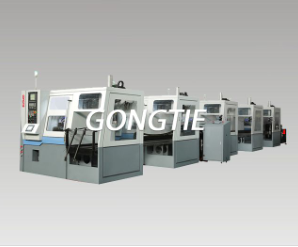Here is Precision CNC Lathe Machine Manufacturer talking about Study on the close contact length of knife-chip in metal cutting.
If you have any idea about Precision CNC Lathe With Lighting System, welcome to contact us and discuss.
1. Knife-to-chip contact length is an important factor affecting the cutting process in metal cutting. It directly reflects the friction state of the cutting process and affects the cutting force, cutting temperature, tool wear, chip formation and the quality of the machined surface. According to a large number of studies by scholars at home and abroad, the blade-to-chip contact area of the rake face can be divided into a compact contact zone and a peak-point contact zone: the length of the compact contact zone is determined by the knife-chip plastic zone, and the peak zone contact zone It reflects the friction state of the chip and the rake face when the chip is rigidly discharged. Since the current determination of the length of the knife-to-chip contact is mostly experimental, there are still many unresolved questions about the definition of tight contact and peak-point contact and the relationship between the two. The calculation and its relationship with the cutting parameters still require a deep theoretical study. Liu Xiangdong and Zhou Zehua's "Metal Cutting Cutter - Study on the Length of Contact Area of Chips and Peak Point Types" has systematically studied the length of the knife-chip compact type and the peak-point contact area and derived the knife-chip compact type. The theoretical calculation formula of the peak-point contact length, but the shear strength tint of the underlying metal in the compact contact zone cannot be theoretically determined and cannot be measured. The obtained formula can only be qualitatively compared and analyzed with the experimental results. Therefore, although the formula has theoretical significance, it cannot be used for the actual calculation of the knife-to-chip compact type and the peak-point contact length. Since the frictional force of the peak-point contact zone is negligible relative to the tight contact zone during the actual cutting process, the study of the frictional force of the compact contact zone is more important. For this reason, the workpiece material is regarded as the ideal rigid elastomer. The calculation formula of the knife-chip tight contact length is theoretically derived by using the Li-Shaffer single shear plane model, which proves that the knife-chip tight contact length is cutting. The results of the combined action of the first and second deformation zones and the rationality and scope of application of the formula were analyzed through experiments.

2. The formula for calculating the contact length of the knife-chip
AB is an imaginary boundary of the entire plastic deformation zone. It is assumed that the material above the AB surface is forming chips and making a rigid upward movement (chip movement), so AB is a free boundary with zero loads thereon; OA and AB are plastic zones. The boundary OAB with the rigid zone is a fully plastic zone and constitutes a uniform field.
The normal and shear stresses on the AB surface are both zero and are at the origin of the coordinates. On the stress circle, AO is rotated 90° clockwise from AB. The BC is rotated counterclockwise by AB to obtain BC and then rotated by 2h from BC to obtain the rake face BO.
During the cutting process, the cutting layer is deformed into chips due to the pushing of the rake face of the tool and then flows out along the rake face. Therefore, the friction on the blade-to-chip contact surface consists of two parts: friction between the rigid tool and the plastically deformed cutting layer material, which is tight contact friction; 2 when the cutting layer material is converted into chips. And the friction between the rake face and the chip when flowing out along the rake face in the rigid body motion mode, at which time the contact between the blade and the chip is a peak-point contact. Therefore, from the Li-Xiefer slip line field model shown in Fig.
According to the geometric relationship, we can infer that ln=aesin(f+b-g0sinfcosb is reduced to ln=ae[L(µ-tang0)+1/cosg0](1) where: ae——cutting thickness
F——shear angle
B——the average friction angle of the rake face
G0——tool rake angle
L—— deformation coefficient, L=[cos(f-g0)];
Since the deformation coefficient L mainly reflects the size of the kiss-cut deformation of the first deformation zone and the average friction coefficient of the rake face, it comprehensively reflects the interaction between the rake face and the chip (that is, the case of the second deformation zone), so (1) It can be seen that the close contact length of the knife-chip is the result of the combined action of the first and second deformation zones during the cutting process.
Copyright © Ningbo Gongtie Smart Technology Co., Ltd. All Rights Reserved | Sitemap Powered by 
